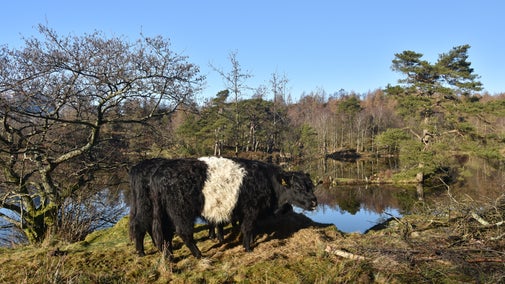
Discover more at Tarn Hows and Coniston
Find out how to get to Tarn Hows and Coniston, where to park, the things to see and do and more.

Tarn Hows was originally three natural tarns (or lakes) but when the owner of the Monk Coniston estate, James Garth Marshall, bought it in the 1860s he started on a project to create a new body of water to feed his sawmill in Coniston surrounded by a bold, ornamental planting scheme.
Marshall’s vision for his designed landscape at Tarn Hows involved clumps of trees planted in a carefully considered way, highlighting rocky knolls and the dramatic Lakes landscape beyond. To protect his new planting of broadleaf trees such as sycamore, beach, alder, cherry and willow, he also planted ‘nurse’ crops of conifers including larch and spruce.
These caretaking ‘nurse’ conifers were intended to protect the young saplings from the harsh winter weather and would be removed once the young broadleaf trees were established.
However, Marshall died before his vision was realised and the nurse crops were never removed. The larch and spruce trees then grew to dominate the Tarn Hows panorama as we know it today.

In 1930, thanks to fundraising and significant donations, the National Trust purchased and took management of a large part of the Monk Coniston estate from the Marshall family, as did Beatrix Potter and her husband William Heelis. Latterly Potter sold more of it to the National Trust and bequeathed the remainder in her will.
The Trust has been working to restore elements of the original designed landscape whilst protecting rare habitats and enhancing the mire systems, which in turn nurtures the species in the area.
Driven by benefits to nature and respecting its designation as a Site of Special Scientific Interest (since 1965), the work will also give visitors a chance to enjoy as wide a range of natural experiences as possible.
The National Trust is continuing to monitor and plan what Tarn Hows will look like in the future – a plan which will preserve, but also enhance, the Tarn’s already high status as a habitat and the significant balance of both created and natural values that have existed at Tarn Hows for over 150 years.

Find out how to get to Tarn Hows and Coniston, where to park, the things to see and do and more.
Explore the varied landscape of the Lake District around Tarn Hows and Coniston. With endless walk and cycle routes and a Tramper to borrow, there’s something for everyone.

To look after special places such as Tarn Hows and Coniston, read about the regular conservation work that takes place every day so that it is protected for everyone, for ever.

Learn about people from the past, discover remarkable works of art and brush up on your knowledge of architecture and gardens.
